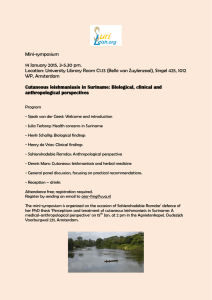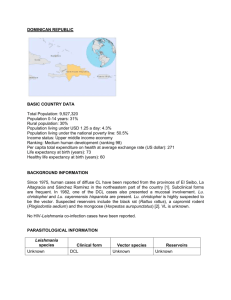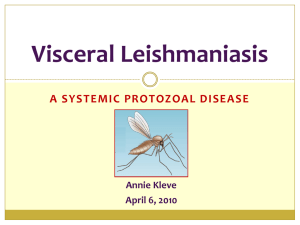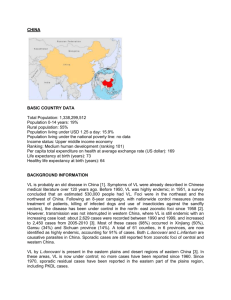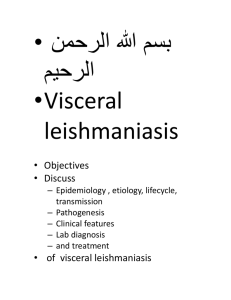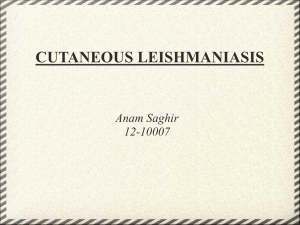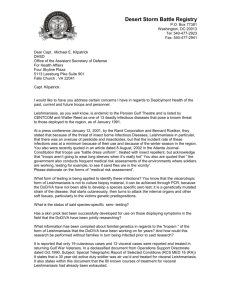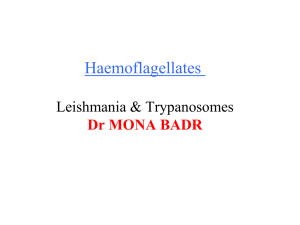Toll-like receptor agonists in immunotherapy of Leishmaniasis 1
advertisement
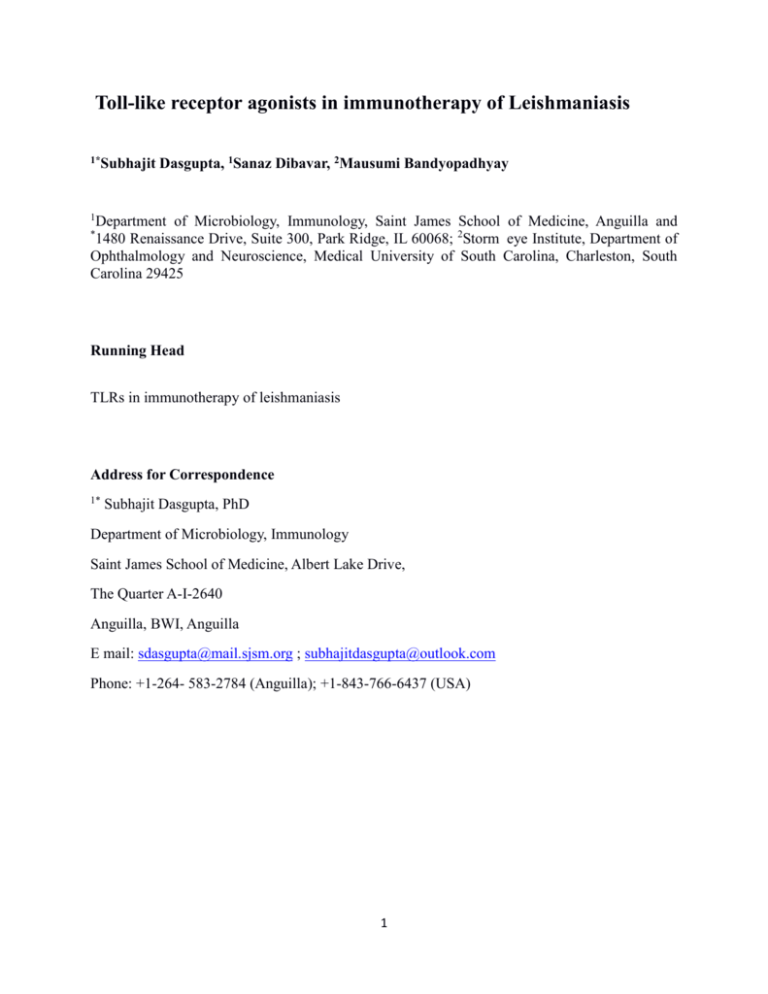
Toll-like receptor agonists in immunotherapy of Leishmaniasis 1*Subhajit Dasgupta, 1Sanaz Dibavar, 2Mausumi Bandyopadhyay 1 Department of Microbiology, Immunology, Saint James School of Medicine, Anguilla and 1480 Renaissance Drive, Suite 300, Park Ridge, IL 60068; 2Storm eye Institute, Department of Ophthalmology and Neuroscience, Medical University of South Carolina, Charleston, South Carolina 29425 * Running Head TLRs in immunotherapy of leishmaniasis Address for Correspondence 1* Subhajit Dasgupta, PhD Department of Microbiology, Immunology Saint James School of Medicine, Albert Lake Drive, The Quarter A-I-2640 Anguilla, BWI, Anguilla E mail: sdasgupta@mail.sjsm.org ; subhajitdasgupta@outlook.com Phone: +1-264- 583-2784 (Anguilla); +1-843-766-6437 (USA) 1 Abbreviations: TLR: toll-like receptors; NF-κB : nuclear factor kappa B; CL :cutaneous leishmaniasis; VL: visceral leishmaniasis; PKADL: post-kala-azar dermal leishmaniasis; LTA: lipoteichoic acid; IL: interleukin; TNF-ɑ : tumor necrosis factor-alpha 2 Abstract Implication for toll-like receptor agonists in immunotherapy is a new approach in prevention of immunosuppression during fatal Leishmania parasite infection. The objective of such immunotherapy is to activate specific cell-mediated immune responses, macrophage activation and antigen responsive inflammation to kill intracellular amastigotes. The efficacy of TLR agonist-based treatment in immunocompetent hosts can be achieved either by selective use of TLR agonists alone or in combination with anti-leishmanial drug stibanate. Recent investigations suggest TLR signal pathways as possible new mode of anti-leishmanial treatment. In this article, we describe the prospect of TLR –mediated signal pathways in immunotherapy of cutaneous and visceral leishmaniasis as well as post kala-azar dermal leishmaniasis (PKADL), a skin-sequel of visceral leishmaniasis. In the context, our proposition is to develop suitable synthetic agonists for TLRs to overcome immunosuppression. 3 Key words: TLR, Leishmania, immunotherapy, resiquimod 4 1.Toll-like receptors in microbial infection Toll-like receptors (TLRs) are the innate immune responders of mammals. The unique feature of TLRs is that these versatile groups of receptor proteins respond to selective microbial PathogenAssociated Molecular Patterns (PAMPs) [1-3]. The sequence and molecular structure of ligands or agonists determine TLR activation and subsequent signal pathways in cells of different tissues. The ligand specific selective activation of TLRs plays a critical role in the development and maintenance of hosts’ immune responses. The expression of TLRs has been found in myeloid and lymphoid progenitor derived cells as well as natural killer (NK) cells. Their presence indicates the importance of TLR-signals in maintaining a bridge between innate and adaptive immune systems although the mechanisms of these systems are not known yet. In addition, TLR- signal pathways play a significant role in brain development [4-7]. The TLRs in mammals are analogous to fruit fly Drosophilla Toll protein, which confers antifungal property to the fly [8,9]. The first discovered TLR is TLR1, attached with interleukin 1 receptor (IL1R) [10]. The TLRs were divided into two groups: (A ) intracellular TLRs, like TLR 3, 6, 9, 7, 8 and (B ) extracellular TLRs, such as TLR 1, 2, 4, 5 [10,11]. The uniqueness of these TLR responses critically depend on ligand specificity, receptor-ligand interaction, and the type of cell signal events that eventually induce downstream activation of transcriptional regulators to promote inflammatory responses (Fig.1). Though the TLRs are expressed in almost all mammalian cells, its mode of action varies in different cells and tissues. The extracellular TLR-mediated immune responses involve upstream activation of multiple signal cascades, which lead to the induction of downstream nuclear factor -κB (NF- κB) and AP5 1 activation [3, 12, 13]. The structure of TLRs includes Leucin-rich repeat sequences. These sequences recognize molecular pattern specific ligands and transmembrane TIR (Toll/ Interleukin 1 receptor 1) domains. The TIR domain is linked with adaptor molecules TIRAP, MyD88, IRAK4, IRAK 1/2 [2,13,14]. Inhibition of MyD88 activation remarkably reduces TLR mediated inflammation. Interestingly, intracellular TLR3 mediated cell signal events have been found to interact with TRIF but not MyD88 in the upstream signal pathway linking IRF transcription regulator(s) to produce antiviral type 1 interferon [10, 13]. The downstream of TLR3- mediated signal event is partially related with MyD88 dependent TLR4 signal pathway connecting activation signals for NF-κB as well as IRF3. The TLR3 agonist polyIpolyC (pIpC) induces mRNA expression of inducible nitric oxide synthase (iNOS) in macrophages [15, 16]. The observations suggested that, pIpC has the ability to cross-signal through TRIF and MyD88 which, in turn, activates IRFmediated signal and downstream cytoplasmic MAPK pathway for activation of NF-κB or AP1. The screening of agonists for TLR2 and TLR3, thus, has importance in determining successful antimicrobial defense approach. Recent advancements also suggest the importance of TLR signal in induction of noncoding microRNA formation (miR-155) [17]. The microRNA, miR-155, is TLR inducible and modifies MyD88 function. Apart from inflammatory responses, induction of miRNA provides an important modulatory mechanism in TLR function. 1.1.Impact of toll-like receptors in cutaneous leishmaniasis The manifestations of cutaneous leishmaniasis (CL) are associated with nodular skin lesions in patients. The endemic zones for cutaneous leishmaniasis include Central and South America, 6 Africa, Middle East and Mediterranean regions [18-20]. The blood borne parasites Leishmania tropica, Leishmania major, and a wide range of different species and subspecies cause cutaneous leishmaniasis. The mechanism of localized immune responses to CL causing parasites is not clear yet. However, the investigations in different laboratories suggest a distinct nature of parasite and cell-mediated immune response against CL parasite antigen in skin nodular lesions which varies in CL from muco-cutaneous (MCL) or in diffuse-cutaneous (DCL) leishmaniasis. The classic cutaneous leishmaniasis is self-healing and is associated with strong T cell- mediated immune responses following infection [21, 22]. The persistence of leishmania infection in CL depends on survival ability of leishmania parasite in macrophages skin tissue. Unlike spleen and liver macrophages in visceral leishmaniasis, the infiltrated macrophages and skin-derived dendritic cells (Langerhan’s cells) have ability to harbor the Leishmania infections. The selfhealing infection persists for long periods in the skin as nodular lesions. Recent investigations suggest the protective role of TLR2 and TLR4 agonists in cutaneous leishmaniasis. Reports from different investigators on American Cutaneous Leishmaniasis (ACL) indicate a protective role of extracellular TLR2 agonist under active disease conditions [23-25]. Cezario et al. [26] and other investigators from different laboratories [27, 28] demonstrated an increase in mRNA expression of TLR 2, 4; interferon gamma (IFN γ); tumor necrosis factor alpha (TNF- α) with parasite infection. These results indicate that, selective agonist-mediated TLR 2, 4 activation is a strategic way in developing anti-leishmanial vaccine. Recently, Raman et al. demonstrated a synergistic application of toll-like receptor 4 and 9 agonists with leishmanial antigen which induces effective anti-leishmanial immune responses [29]. In search for possible therapeutic interventions with minimum side effect, a combination therapy of stibanate with TLR3 synthetic agonist polyIpolyC is indicated as vital step towards 7 immunotherapy [30]. Likewise, the use of bacterial membrane component muramyl dipeptide (MDP) as an immunoadjuvant is another important step towards development of immunotherapy in animal models [31]. Activation of natural killer T cells (T cytotoxic cells) through TLRmediated signal is a classic impact to induce killing of intracellular parasite loaded macrophages and thereby demonstrates importance of TLR agonists in prevention of leishmaniasis [32]. The TLR 7/8 ligand, imidazoquinoline compound imiquimod or resiquimod is a potential antimicrobial agent. The imiquimod is FDA approved compound for topical treatment of genital warts [33,34]. Another importance of this compound has been found in treatment of leishmaniasis. Thus, selective use of TLR agonists provides anti-leishmanial effect with benefit in public health. In cutaneous leishmaniasis, topical use of TLR agonists is noninvasive choice of immunotherapy. 1.2.Impact of toll-like receptors in visceral leishmaniasis Unlike cutaneous leishmaniasis, visceral leishmaniasis (VL) is a fatal progressive disease caused by vector Phlebotomine sandfly. The leishmania antigen specific immunosuppression is a major event during progression of the disease [35- 38]. The leishmania antigen specific lymphoproliferative responses have been demonstrated by many investigators suggesting intrinsic impairment of T helper type 1 cell activation during progression of illness. Leishmania donovani infection eventually results in two different patterns of immune responses: antigen specific immune suppression and antigen unspecific generalized immunosuppression. The longitudinal study in hamster model indicated an overall decrease in lymphoproliferative responses with progressive L. donovani infection [38-41]. It has been demonstrated that, the adherent immune cells of macrophage origin are the cause of impairment 8 of cell-mediated immune responses. This was concluded based on the results, where the removal of these adherent cells partially restored the lymphoproliferative responses [39]. Thus, the mechanistic possibilities for immunosuppression in susceptible hosts include, (1) altered antigen presentation by APCs (antigen presenting cells) as well as (2) the dysfunction of T helper cells to commit TH1 or TH17 type response in presence of leishmania antigen (Fig. 2). The findings in the hamster model provide a way to determine diversity of APCs to generate effective population of antigen specific T cells. The importance of toll-like receptors is a challenging aspect in developing vaccination in management of visceral leishmaniasis (VL). Several investigators [42,43] suggested that, the induction of IL1, TNF-α, and IFN -ɣ reduced intracellular Leishmania donovani accumulation in monocytes in vitro. Kar et al. [44] suggested a role of cystatin in the prevention of visceral leishmaniasis via induction of NF-κB mediated pro-inflammatory responses in downstream of TLR/ MyD88 signaling pathway. 1.3.Impact of TLRs on post-kala-azar dermal leishmaniasis (PKADL) Post-kala-azar dermal leishmaniasis (PKADL) is a sequel of visceral leishmaniasis (VL) [45-47]. The nodular lesions on skin of VL patients develop due to improper drug treatment and the development of dysfunctional hosts' immune responses against Leishmania donovani parasite. The current medications using stibanate (Pentostam) have limitations of curing leishmania infection. Several reports [48- 49] suggest the drug resistant variety of Leishmania donovani generates skin nodular lesions and remain outside the immunocompetent hosts. The PKADL is an example of reversible immune responses to leishmania antigen(s).The impact of TLRs in PKADL treatment is still unknown. Immunotherapy using selective TLR agonists would be a 9 better choice to treat the nodular lesions and activate localized immune responses in PKADL patients. 2.Prospect of TLR agonists as Immunotherapeutic agents for Leishmaniasis In spite of extensive research, the immunotherapeutic approach and vaccination strategy to prevent cutaneous and visceral leishmaniasis is still under investigation. The relative shortcomings in management of leishmaniasis remain on vector biology, variation in parasite antigens, and genetic susceptibility of hosts towards Leishmania infection [50, 51]. The positive correlation between geographical location and host-parasite interaction pattern is still unclear. The Leishmania parasites grow and multiply intracellularly within macrophage [52, 53]. Due to its special site, the parasites escape direct interaction with drug. At the same time, dysfunction of antigen presentation by amastigote infected macrophages and professional antigen presenting cells leads towards decrease in T helper type 1-mediated inflammatory response which is required to kill parasites. Since there is still no effective immunotherapy, the longtime reliable pentostam (sodium stibogluconate or stibanate) is still used as a drug of choice for leishmaniasis [54- 56]. The recent investigations towards therapy of leishmaniasis indicate to develop noninvasive treatment procedure in skin lesions of cutaneous forms of leishmania infection. Thus, a strategy to generate effective topical medicine has found profound importance. Recent laboratory based investigations suggested the importance of resiquimod alone and in the form of liposomal resiquimod (imidazoquinoline) in treatment of visceral leishmaniasis [57, 58]. However, in depth immunotherapy based research is still a requirement to prevent different forms of leishmaniasis in modern world. The prospect of TLR agonist based immunotherapy is thus a 10 promise in treatment of immunosuppression in visceral leishmaniasis which provides us with beneficial effective treatment to reduce parasite load and fatal outcome due to Leishmania donovani infection. 11 . 3.Acknowledgement We acknowledge resources in Saint James School of Medicine. I (SDG) acknowledge the project on study of immunosuppression and toll-like receptors in leishmaniasis. 12 4.Disclosures We do not have any conflicts of interests. 13 5.References 1.Takeuchi O, Akira S. Toll-like receptors; their physiological role and signal transduction system. Int Immunopharmacol 2001; 1(4):625-35. 2.Chaudhary PM, Ferguson C, Nguyen V, et al. Cloning and characterization of two Toll/Interleukin-1 receptor-like genes TIL3 and TIL4: evidence for a multi-gene receptor family in humans. Blood 1998; 91(11):4020-7. 3.Zhu J, Mohan C. Toll-like receptor signaling pathways--therapeutic opportunities. Mediators Inflamm 2010; 2010:781235. 4.Okun E, Griffioen KJ, Mattson MP. Toll-like receptor signaling in neural plasticity and disease. Trends Neurosci 2011; 34(5):269-81. 5.Olson JK, Miller SD. Microglia initiate central nervous system innate and adaptive immune responses through multiple TLRs. J Immunol 2004; 173(6):3916-24. 6.Hanke ML, Kielian T. Toll-like receptors in health and disease in the brain: mechanisms and therapeutic potential. Clin Sci (Lond) 2011; 121(9):367-87. 7.Kaul D, Habbel P, Derkow K, et al. Expression of Toll-like receptors in the developing brain. PLoS One 2012; 7(5):e37767. 8.Gangloff M, Weber AN, Gibbard RJ, Gay NJ. Evolutionary relationships, but functional differences, between the Drosophila and human Toll-like receptor families. Biochem Soc Trans 2003; 31(Pt 3):659-63. 9.Tanji T, Ip YT. Regulators of the Toll and Imd pathways in the Drosophila innate immune 14 response. Trends Immunol 2005; 26(4):193-8. 10.Kawai T, Akira S. TLR signaling. Cell Death and Differentiation 2006; 13:816-25. 11.Thoma-Uszynski S, Stenger S, Takeuchi O, et al. Induction of direct antimicrobial activity through mammalian toll-like receptors. Science 2001; 291(5508):1544-7. 12.Valkov E, Stamp A, Dimaio F, et al. Crystal structure of Toll-like receptor adaptor MAL/TIRAP reveals the molecular basis for signal transduction and disease protection. Proc Natl Acad Sci U S A 2011; 108(36):14879-84. 13.Schilling D, Thomas K, Nixdorff K, Vogel SN, Fenton MJ. Toll-like receptor 4 and Toll-IL-1 receptor domain-containing adapter protein (TIRAP)/myeloid differentiation protein 88 adapterlike (Mal) contribute to maximal IL-6 expression in macrophages. J Immunol 2002; 169(10):5874-80. 14.Martin MU, Wesche H. Summary and comparison of the signaling mechanisms of the Toll/interleukin-1 receptor family. Biochim Biophys Acta 2002; 1592(3):265-80. 15.Snell JC, Chernyshev O, Gilbert DL, Colton CA. Polyribonucleotides induce nitric oxide production by human monocyte-derived macrophages. J Leukoc Biol 1997; 62(3):369-73. 16.Heitmeier MR, Scarim AL, Corbett JA. Double-stranded RNA-induced inducible nitric-oxide synthase expression and interleukin-1 release by murine macrophages requires NF-kappaB activation. J Biol Chem 1998; 273(24):15301-7. 17.Tili E, Croce CM, Michaille JJ. miR-155: on the crosstalk between inflammation and cancer. Int Rev Immunol 2009; 28(5):264-84. 15 18.Alvar J, Velez ID, Bern C, Herrero M, Desjeux P, Cano J, Jannin J, den Boer M. Leishmaniasis worldwide and global estimates of its incidence. PLoS One 2012; 7(5):e35671. 19.de Brito ME, Andrade MS, Dantas-Torres F, Rodrigues EH, Cavalcanti Mde P, de Almeida AM, Brandao-Filho SP. Cutaneous leishmaniasis in northeastern Brazil: a critical appraisal of studies conducted in State of Pernambuco. Rev Soc Bras Med Trop 2012; 45(4):425-9. 20.Llambrich A, Zaballos P, Terrasa F, Torne I, Puig S, Malvehy J. Dermoscopy of cutaneous leishmaniasis. Br J Dermatol 2009; 160(4):756-61. 21.Bacellar O, Faria D, Nascimento M, Cardoso TM, Gollob KJ, Dutra WO, Scott P, Carvalho EM. Interleukin 17 production among patients with American cutaneous leishmaniasis. J Infect Dis 2009; 200(1):75-8. 22.Castellano LR, Filho DC, Argiro L, Dessein H, Prata A, Dessein A, Rodrigues V. Th1/Th2 immune responses are associated with active cutaneous leishmaniasis and clinical cure is associated with strong interferon-gamma production. Hum Immunol 2009; 70(6):383-90. 23.Von Stebut E. Immunology of cutaneous leishmaniasis: the role of mast cells, phagocytes and dendritic cells for protective immunity. Eur J Dermatol 2007; 17(2):115-22. 24.Vargas-Inchaustegui DA, Tai W, Xin L, Hogg AE, Corry DB, Soong L. Distinct roles for MyD88 and Toll-like receptor 2 during Leishmania braziliensis infection in mice. Infect Immun 2009; 77(7):2948-56. 25.Tuon FF, Fernandes ER, Duarte MI, Amato VS. Expression of TLR2 and TLR4 in lesions of patients with tegumentary American leishmaniasis. Rev Inst Med Trop Sao Paulo 2012; 54(3):159-63. 16 26.Cezario GA, de Oliveira LR, Peresi E, Nicolete VC, Polettini J, de Lima CR, Gatto M, Calvi SA. Analysis of the expression of toll-like receptors 2 and 4 and cytokine production during experimental Leishmania chagasi infection. Mem Inst Oswaldo Cruz 2011; 106(5):573-83. 27.Schnorr D, Muniz AC, Passos S, Guimaraes LH, Lago EL, Bacellar O, Glesby MJ, Carvalho EM. IFN-gamma production to leishmania antigen supplements the leishmania skin test in identifying exposure to L. braziliensis infection. PLoS Negl Trop Dis 2012; 6(12):e1947. 28.Da-Cruz AM, de Oliveira MP, De Luca PM, Mendonca SC, Coutinho SG. Tumor necrosis factor-alpha in human american tegumentary leishmaniasis. Mem Inst Oswaldo Cruz 1996; 91(2):225-9. 29.Raman VS, Bhatia A, Picone A, et al. Applying TLR synergy in immunotherapy: implications in cutaneous leishmaniasis. J Immunol 2010; 185(3):1701-10. 30.Bhakuni V, Kulkarni S, Singh UK et al. Immunochemotherapy for Leishmania donovani infection in golden hamsters:combinatorial action of polyICLC plus L-arginine and sodium stibogluconate (Stibanate). J. Interferon Cytokine Res 1999;10:1103-6. 31.Singh RK, Srivastava A, Singh N. Toll-like receptor signaling: a perspective to develop vaccine against leishmaniasis. Microbiol Res 2012; 167(8):445-51. 32.Karmakar S, Bhaumik SK, Paul J, De T. TLR4 and NKT cell synergy in immunotherapy against visceral leishmaniasis. PLoS Pathog 2012; 8(4):e1002646. 33.Rudy SJ. Imiquimod (Aldara): modifying the immune response. Dermatol Nurs 2002; 14(4):268-70. 34.Miller RL, Meng TC, Tomai MA. The antiviral activity of Toll-like receptor 7 and 7/8 17 agonists. Drug News Perspect 2008; 21(2):69-87. 35.Neogy AB, Nandy A, Ghosh Dastidar B, Chowdhury AB. Modulation of the cell-mediated immune response in kala-azar and post-kala-azar dermal leishmaniasis in relation to chemotherapy. Ann Trop Med Parasitol 1988; 82(1):27-34. 36.Carvalho EM, Teixeira RS, Johnson WD, Jr. Cell-mediated immunity in American visceral leishmaniasis: reversible immunosuppression during acute infection. Infect Immun 1981; 33(2):498-500. 37.Carvalho EM, Bacellar O, Barral A, Badaro R, Johnson WD, Jr. Antigen-specific immunosuppression in visceral leishmaniasis is cell mediated. J Clin Invest 1989; 83(3):860-4. 38.Goto H, Lindoso JA. Immunity and immunosuppression in experimental visceral leishmaniasis. Braz J Med Biol Res 2004; 37(4):615-23. 39.Dasgupta S, Mookerjee A, Chowdhury SK, Ghose AC. Immunosuppression in hamsters with progressive visceral leishmaniasis: an evaluation of the role of nitric oxide toward impairment of the lymphoproliferative response. Parasitol Res 1999; 85(7):594-6. 40.Gifawesen C, Farrell JP. Comparison of T-cell responses in self-limiting versus progressive visceral Leishmania donovani infections in golden hamsters. Infect Immun 1989; 57(10):3091-6. 41.Melby PC, Chandrasekar B, Zhao W, Coe JE. The hamster as a model of human visceral leishmaniasis: progressive disease and impaired generation of nitric oxide in the face of a prominent Th1-like cytokine response. J Immunol 2001; 166(3):1912-20. 42.Paul J, Karmakar S, De T. TLR-mediated distinct IFN-gamma/IL-10 pattern induces protective immunity against murine visceral leishmaniasis. Eur J Immunol 2012; 42(8):2087-99. 18 43.Reiner NE, Ng W, Wilson CB, McMaster WR, Burchett SK. Modulation of in vitro monocyte cytokine responses to Leishmania donovani. Interferon-gamma prevents parasite-induced inhibition of interleukin 1 production and primes monocytes to respond to Leishmania by producing both tumor necrosis factor-alpha and interleukin 1. J Clin Invest 1990; 85(6):1914-24. 44.Kar S, Ukil A, Das PK. Cystatin cures visceral leishmaniasis by NF-kappaB-mediated proinflammatory response through co-ordination of TLR/MyD88 signaling with p105-Tpl2-ERK pathway. Eur J Immunol 2011; 41(1):116-27. 45.Haldar JP, Ghose S, Saha KC, Ghose AC. Cell-mediated immune response in Indian kala-azar and post-kala-azar dermal leishmaniasis. Infect Immun 1983; 42(2):702-7. 46.Ganguly S, Das NK, Barbhuiya JN, Chatterjee M. Post-kala-azar dermal leishmaniasis--an overview. Int J Dermatol 2010; 49(8):921-31. 47.Zijlstra EE, Musa AM, Khalil EA, el-Hassan IM, el-Hassan AM. Post-kala-azar dermal leishmaniasis. Lancet Infect Dis 2003; 3(2):87-98. 48.Singh R, Kumar D, Ramesh V, Negi NS, Singh S, Salotra P. Visceral leishmaniasis, or kala azar (KA): high incidence of refractoriness to antimony is contributed by anthroponotic transmission via post-KA dermal leishmaniasis. J Infect Dis 2006; 194(3):302-6. 49.Subba Raju BV, Gurumurthy S, Kuhls K, Bhandari V, Schnonian G, Salotra P. Genetic typing reveals monomorphism between antimony sensitive and resistant Leishmania donovani isolates from visceral leishmaniasis or post kala-azar dermal leishmaniasis cases in India. Parasitol Res 2012; 111(4):1559-68. 50.Blackwell JM, Fakiola M, Ibrahim ME, et al. Genetics and visceral leishmaniasis: of mice 19 and man. Parasite Immunol 2009; 31(5):254-66. 51.Fakiola M, Miller EN, Fadl M, et al. Genetic and functional evidence implicating DLL1 as the gene that influences susceptibility to visceral leishmaniasis at chromosome 6q27. J Infect Dis 2011; 204(3):467-77. 52.Mauel J. Macrophage-parasite interactions in Leishmania infections. J Leukoc Biol 1990; 47(2):187-93. 53.Ridley MJ, Wells CW. Macrophage-parasite interaction in the lesions of cutaneous leishmaniasis. An ultrastructural study. Am J Pathol 1986; 123(1):79-85. 54.Musa A, Khalil E, Hailu A, et al. Sodium stibogluconate (SSG) & paromomycin combination compared to SSG for visceral leishmaniasis in East Africa: a randomised controlled trial. PLoS Negl Trop Dis 2012; 6(6):e1674. 55.Solomon M, Baum S, Barzilai A, Pavlotsky F, Trau H, Schwartz E. Treatment of cutaneous leishmaniasis with intralesional sodium stibogluconate. J Eur Acad Dermatol Venereol 2009; 23(10):1189-92. 56.Singh N, Kumar M, Singh RK. Leishmaniasis: current status of available drugs and new potential drug targets. Asian Pac J Trop Med 2012; 5(6):485-97 57.Garland SM. Imiquimod. Curr Opin Infect Dis 2003; 16(2):85-9. 58.Peine KJ, Gupta G, Brackman DJ, Papenfuss TL, Ainslie KM, Satoskar AR, Bachelder EM. Liposomal resiquimod for the treatment of Leishmania donovani infection. J Antimicrob Chemother 2013, DOI: dkt320 [pii]10.1093/jac/dkt320. 20
